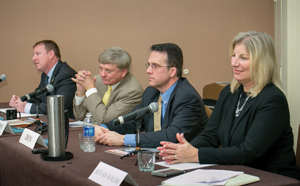When is posting on social media a crime? Panel debates the issue

Michael Moore, Rusty Hardin and Jeffrey Dion made up a panel moderated by Sherri Bevan Walsh that addressed the balance between free speech rights and threats issued online. Photo by Kathy Anderson.
Looking at that case, a panel at the ABA Midyear Meeting debated whether and how social media should change rules that distinguish between free speech and threats in the session “Free Speech and Accountability on Social Media: Where to Draw the Line?”
The threats were not subtle. Panel moderator Sherri Bevan Walsh, the elected prosecutor for Summit County, Ohio, read out loud threats to the former wife that included: “Fold up your [protective order] and put it in your pocket. Is it thick enough to stop a bullet?”
After an FBI agent visited his home in response to these postings, Elonis posted that it “took all the strength I had not to slit her throat.” He also threatened to shoot up a kindergarten and commit violence against law enforcement.
Despite his arguments that he was an aspiring rapper just posting lyrics, he was ultimately convicted of four counts of violating 18 U.S.C. § 875(c), transmitting a communication intended to threaten another.
In his appeal to the high court, Elonis’ attorneys argued the trial court should not have used the current standard for such a conviction—whether the communication would be taken as a threat by a reasonable person—but asked instead whether Elonis himself intended that his posts be taken as a threat.
CONTEXT IS KEY
All of the panelists agreed context is everything in a stalking or abuse situation: A request to “be careful crossing the street” could be taken as threatening under certain circumstances. But the panelists had different approaches to whether and how the law should be changed to account for social media.
Rusty Hardin, a Houston defense attorney, was wary of changing the law “to deal with the hot-button issue of the day.” Prosecutors have to determine intent all the time, he said, and leaving it out can lead to unfair convictions. And what is reasonable, he said, is dangerously subjective.
But Michael Moore, president of the National District Attorneys Association and the elected state’s attorney for Beadle County, South Dakota, said it would be tough to ask juries to determine intent, practically speaking.
“[The jury would] say there’s no doubt he knew he was placing his victim in fear, but did he intend to?” Moore said.
Jeffrey Dion of the National Center for Victims of Crime explained that people will say things online that they’d never say in person.
Hardin argued for a recklessness standard that could cover abusive and cruel behavior, but not prohibit negligent statements. This would be less strict than the current standard, but stricter than the one argued for in Elonis.
Dion’s organization submitted an amicus brief in Elonis supporting the government’s position. The worst thing that could happen to victims here, he said, would be a decision that loosens standards so much, prosecutors no longer have the tools to address stalking.
However, the panelists also agreed that Elonis was properly convicted.
“Bad cases obviously make bad law,” said Hardin. “This guy would have been convicted under any frickin’ standard.”
This article originally appeared in the April 2015 issue of the ABA Journal with this headline: “When is posting on social media a crime? Panel debates the issue.”



